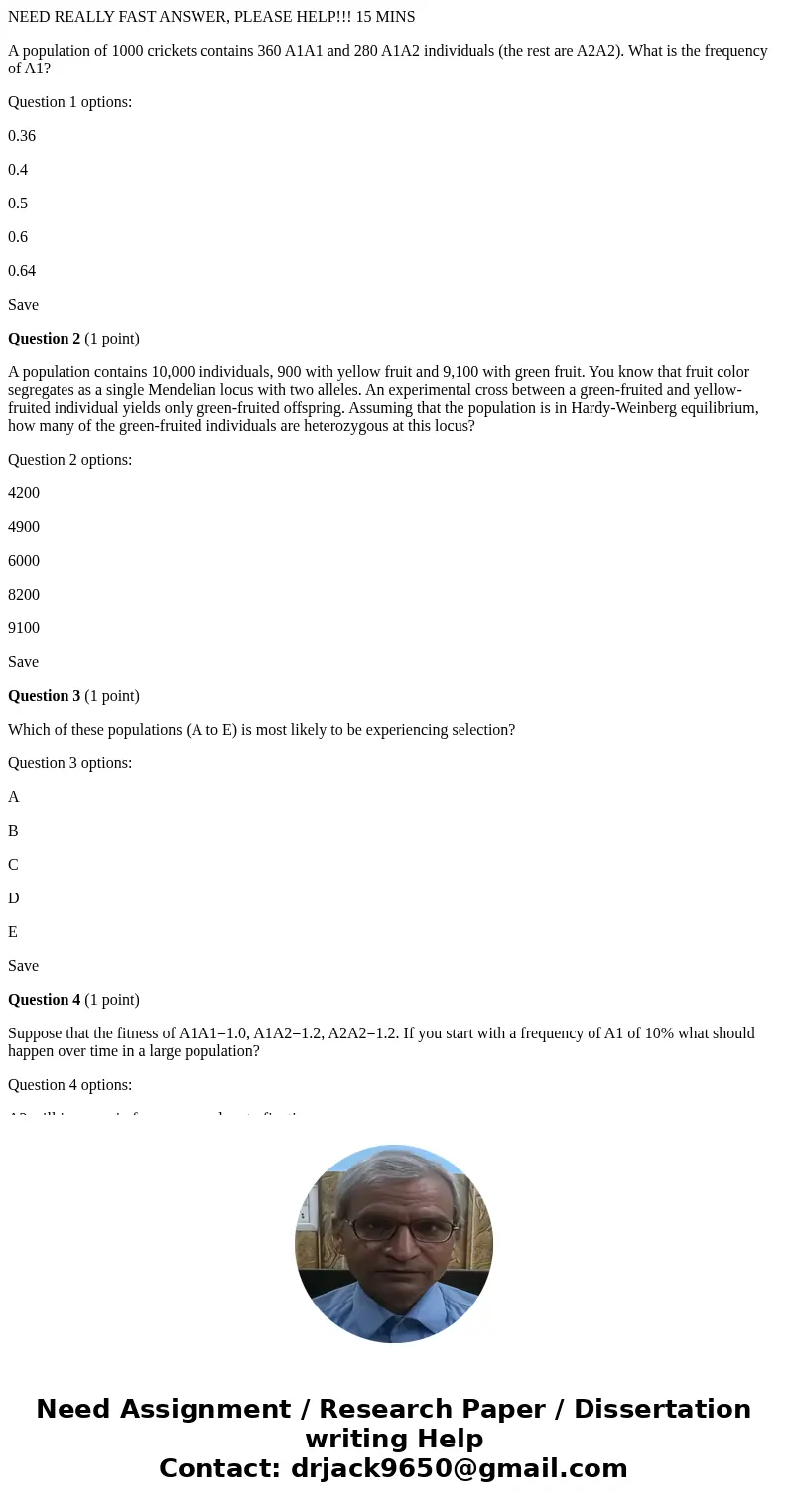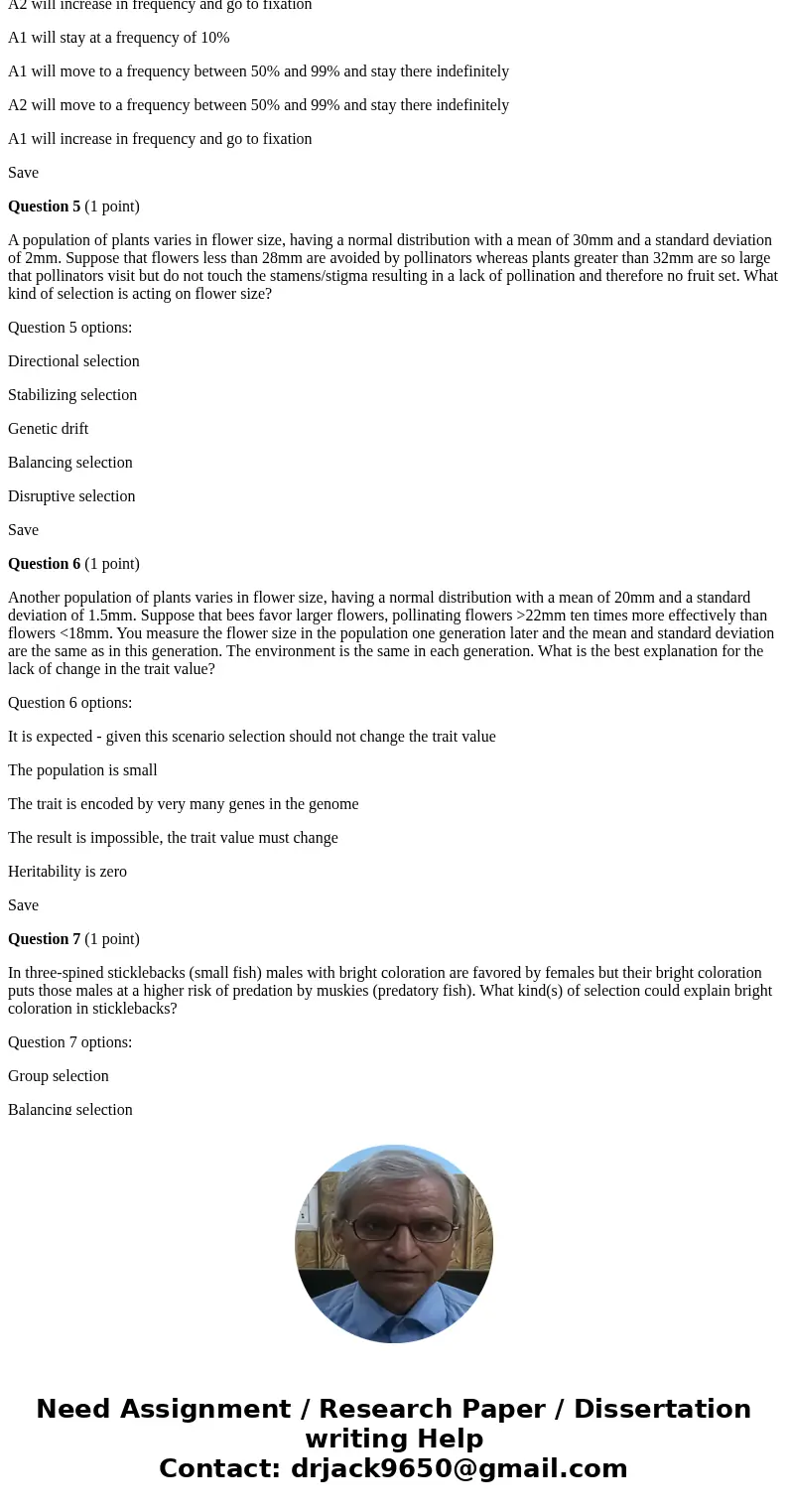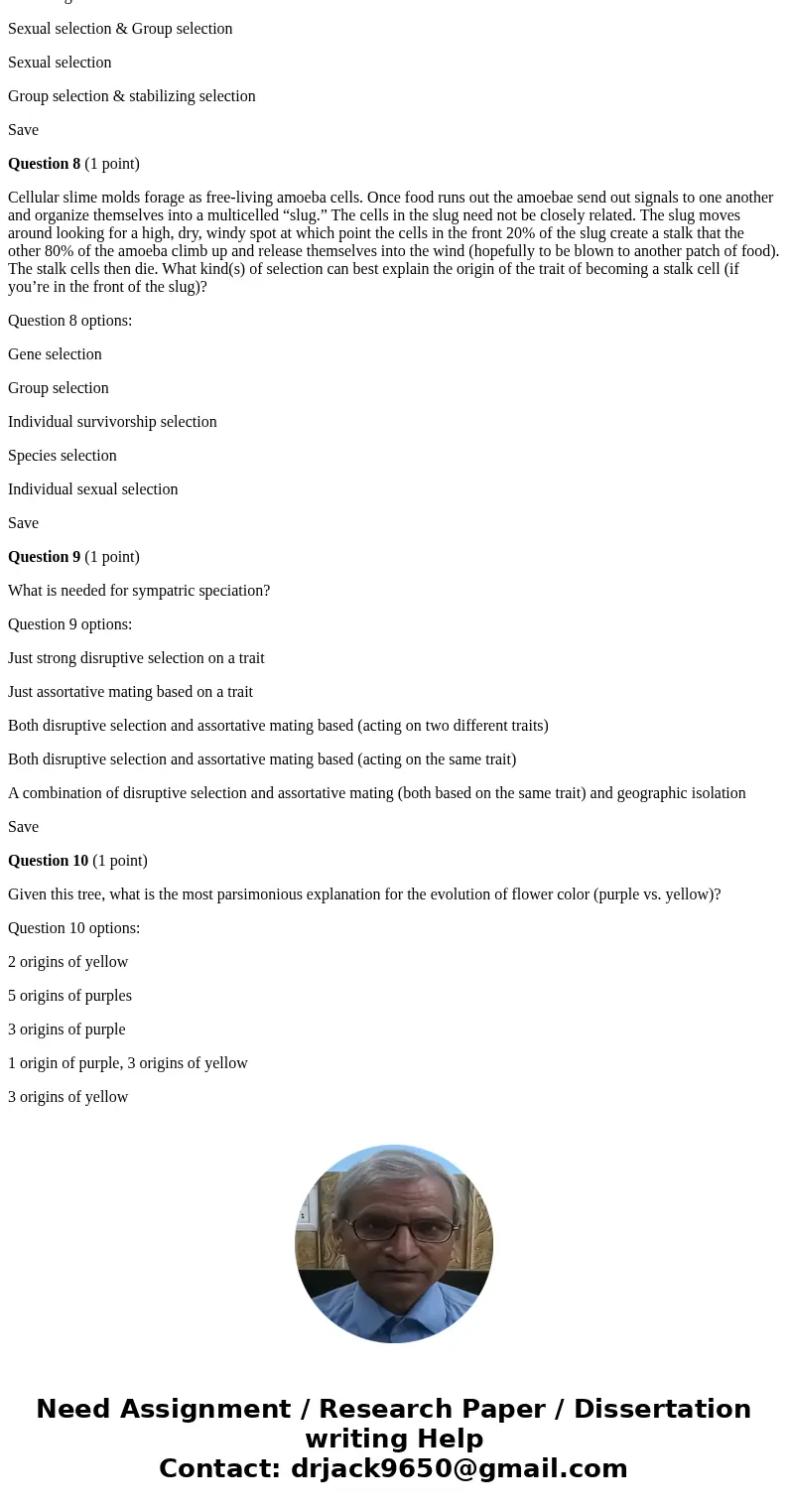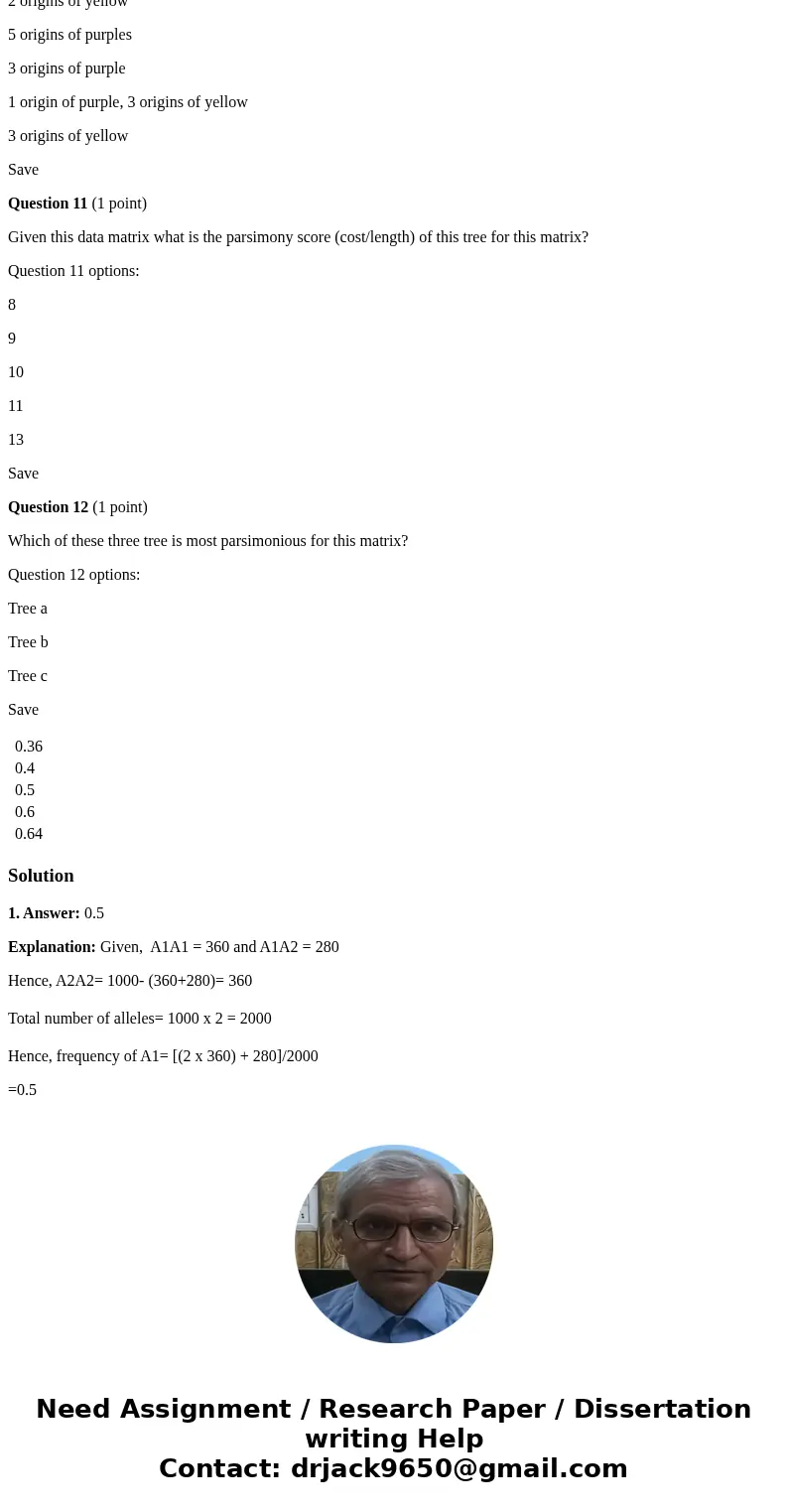NEED REALLY FAST ANSWER PLEASE HELP 15 MINS A population of
NEED REALLY FAST ANSWER, PLEASE HELP!!! 15 MINS
A population of 1000 crickets contains 360 A1A1 and 280 A1A2 individuals (the rest are A2A2). What is the frequency of A1?
Question 1 options:
0.36
0.4
0.5
0.6
0.64
Save
Question 2 (1 point)
A population contains 10,000 individuals, 900 with yellow fruit and 9,100 with green fruit. You know that fruit color segregates as a single Mendelian locus with two alleles. An experimental cross between a green-fruited and yellow-fruited individual yields only green-fruited offspring. Assuming that the population is in Hardy-Weinberg equilibrium, how many of the green-fruited individuals are heterozygous at this locus?
Question 2 options:
4200
4900
6000
8200
9100
Save
Question 3 (1 point)
Which of these populations (A to E) is most likely to be experiencing selection?
Question 3 options:
A
B
C
D
E
Save
Question 4 (1 point)
Suppose that the fitness of A1A1=1.0, A1A2=1.2, A2A2=1.2. If you start with a frequency of A1 of 10% what should happen over time in a large population?
Question 4 options:
A2 will increase in frequency and go to fixation
A1 will stay at a frequency of 10%
A1 will move to a frequency between 50% and 99% and stay there indefinitely
A2 will move to a frequency between 50% and 99% and stay there indefinitely
A1 will increase in frequency and go to fixation
Save
Question 5 (1 point)
A population of plants varies in flower size, having a normal distribution with a mean of 30mm and a standard deviation of 2mm. Suppose that flowers less than 28mm are avoided by pollinators whereas plants greater than 32mm are so large that pollinators visit but do not touch the stamens/stigma resulting in a lack of pollination and therefore no fruit set. What kind of selection is acting on flower size?
Question 5 options:
Directional selection
Stabilizing selection
Genetic drift
Balancing selection
Disruptive selection
Save
Question 6 (1 point)
Another population of plants varies in flower size, having a normal distribution with a mean of 20mm and a standard deviation of 1.5mm. Suppose that bees favor larger flowers, pollinating flowers >22mm ten times more effectively than flowers <18mm. You measure the flower size in the population one generation later and the mean and standard deviation are the same as in this generation. The environment is the same in each generation. What is the best explanation for the lack of change in the trait value?
Question 6 options:
It is expected - given this scenario selection should not change the trait value
The population is small
The trait is encoded by very many genes in the genome
The result is impossible, the trait value must change
Heritability is zero
Save
Question 7 (1 point)
In three-spined sticklebacks (small fish) males with bright coloration are favored by females but their bright coloration puts those males at a higher risk of predation by muskies (predatory fish). What kind(s) of selection could explain bright coloration in sticklebacks?
Question 7 options:
Group selection
Balancing selection
Sexual selection & Group selection
Sexual selection
Group selection & stabilizing selection
Save
Question 8 (1 point)
Cellular slime molds forage as free-living amoeba cells. Once food runs out the amoebae send out signals to one another and organize themselves into a multicelled “slug.” The cells in the slug need not be closely related. The slug moves around looking for a high, dry, windy spot at which point the cells in the front 20% of the slug create a stalk that the other 80% of the amoeba climb up and release themselves into the wind (hopefully to be blown to another patch of food). The stalk cells then die. What kind(s) of selection can best explain the origin of the trait of becoming a stalk cell (if you’re in the front of the slug)?
Question 8 options:
Gene selection
Group selection
Individual survivorship selection
Species selection
Individual sexual selection
Save
Question 9 (1 point)
What is needed for sympatric speciation?
Question 9 options:
Just strong disruptive selection on a trait
Just assortative mating based on a trait
Both disruptive selection and assortative mating based (acting on two different traits)
Both disruptive selection and assortative mating based (acting on the same trait)
A combination of disruptive selection and assortative mating (both based on the same trait) and geographic isolation
Save
Question 10 (1 point)
Given this tree, what is the most parsimonious explanation for the evolution of flower color (purple vs. yellow)?
Question 10 options:
2 origins of yellow
5 origins of purples
3 origins of purple
1 origin of purple, 3 origins of yellow
3 origins of yellow
Save
Question 11 (1 point)
Given this data matrix what is the parsimony score (cost/length) of this tree for this matrix?
Question 11 options:
8
9
10
11
13
Save
Question 12 (1 point)
Which of these three tree is most parsimonious for this matrix?
Question 12 options:
Tree a
Tree b
Tree c
Save
| 0.36 | |
| 0.4 | |
| 0.5 | |
| 0.6 | |
| 0.64 |
Solution
1. Answer: 0.5
Explanation: Given, A1A1 = 360 and A1A2 = 280
Hence, A2A2= 1000- (360+280)= 360
Total number of alleles= 1000 x 2 = 2000
Hence, frequency of A1= [(2 x 360) + 280]/2000
=0.5




 Homework Sourse
Homework Sourse